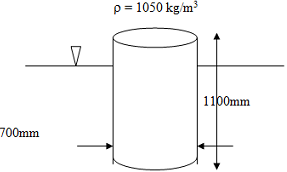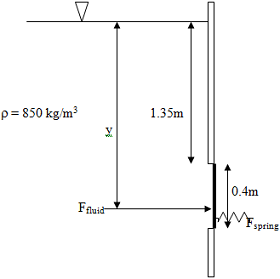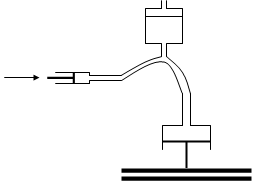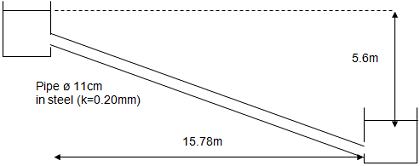Reference no: EM13892782
Scenario
As part of a design engineering team working on building a new ship, you are expected to carry out simple calculations to determine what will happen to the ship at sea water with different density. A simplified version of this scenario is presented in Task 1.
Learning Outcome 1.1
1: Determine the hydrostatic pressure and thrust on immersed surfaces
1) A plastic cube that can be used to design a ship has a dimension of 10 cm on each sideand mass 0.20 kg, with appropriate calculations explain:
a. What happens if the cube is placed in salt water (ρ = 1050 kg/m3)?
b. What happens if the cube is placed in fresh water (ρ = 1000 kg/m3)?
Determine the volume of the water displaced and the submerged depth in (m) in questions (a) and (b) above. Explain also the difference in the answers obtained in (a) and (b) above.
2) A cylindrical steel drum is to be used as a buoy in sea water (ρ = 1050 kg/m3). The drum is 700mm in diameter and 1100mm long and has a mass of 250kg. It is required to float two thirds (2/3) submerged, as shown in Figure 2 below.
a. Calculate the hydrostatic pressure on the drum and the weight of water displaced when the buoy floats 2/3 submerged.
b. Calculate the mass which must be placed in the bottom of the drum to ensure that it floats 2/3 submerged.

Learning Outcome 1.2
1.2: Determine the centre of pressure on immersed surfaces
3) A tank is 500mm by 1100mm in plan and contains water (ρ = 1000 kg/m3) to a depth of 350mm. Calculate the total hydrostatic thrust force and depth to the centre of pressure for:
a. The shorter side, and
b. The longer side.
c. Comment on your findings.
4) A tank of fuel ( ρ = 850 kg/m3) has a circular valve, 0.40m in diameter, which opens when the level of fuel in the tank reaches 1.35m above the hinge. The valve is kept closed by a spring, mounted on the lower edge of the valve, as shown in Figure 3 below.
a. Calculate the thrust on the valve and the depth to the centre of pressure, shown as y in the figure.
b. Calculate the minimum force required in the spring to hold the valve closed at the required level.
c. Comment on the validity of your results.

Learning Outcome 1.3
3: Determine the parameters of devices in which a fluid is used to transmit force
5) A hydraulic press is required to deliver a force of 90kN onto the work surface as shown in Figure 4 below. The piston in the press has a diameter of 320mm.
a. The maximum force which can be applied at the input piston is 1750N. Calculate the optimum diameter of the input piston which will allow the press to operate. Again, ignore any frictional losses.
b. Give two characteristics which are essential in hydraulic fluid for effective operation.
c. Explain two advantages of having a reservoir in the system(maximum of 100 words)

Learning Outcomes 2.1 and 2.2
2.1: Explain the characteristics and parameters of viscosity in fluids.
2.2: Describe viscosity measurement techniques
6) a. Explain the term viscosity in fluids?
b. Describe in detail an experimental procedure you have carried out for the measurement of fluid viscosity (include diagrams of apparatus, experimental data, calculations and an analysis of the nature and effects of experimental errors).Compare your results with a true value of the viscosity of the fluid concerned. Make recommendations for improvements to the experimental procedure.
Learning Outcome 2.3
2.3: Describe the effects of shear force on Newtonian and non-Newtonian fluids
7) Explainin detail the behaviour and the effects of shear force on Newtonian fluids and non-Newtonian fluids(maximum of 500 words excluding diagrams and tables; providereferences for all your sources).
Task 1 - Learning Outcome 3.1
3.1: Determine head losses in pipeline flow
8) Calculate the flow of water under gravity in litres/sec between the two reservoirs in Figure below. It is compulsory to use Moody Chart to determine the friction factor values for your calculations.

Learning Outcome 3.2
3.2: Determine Reynolds' number for a flow system and assess its significance
9) As an engineer in an industry, you are required to pump oil (density 800 kg/m3, viscosity 0.12Ns/m2 and flow rate 0.2m3/s) in a 10 cm diameter pipe over a distance of 100m.
a. Calculate the critical velocity and the actual Reynolds' number in the pipe
b. Calculate the power required (per metre) to pump the oil horizontally at a mass flow rate of 20kg/s.
c. Calculate the power required (per metre) to pump the oil horizontally at a mass flow rate of 100kg/s.
Learning Outcome 3.3
3.3: Determine viscous drag of bluff and streamlined bodies
10)
a. Describe the terms skin friction drag and form drag. (500 words excluding diagrams and tables; provide references for all your sources)
b. A car has an overall drag coefficient CD = 0.25 and a frontal area of A = 1.950m2. The density of air is ρ = 1.29kg/m3. The drag force is found from the formula F = CD.1/2ρAv2 and the power from H = Fv.
Calculate the power required from the car's engine to overcome drag forces at a constant velocity of v = 30 m/s.
c. The thickness of a boundary layer δ on one side of a flat surface is given by the formula:
δ = 0.37 (η/ρV)1/3. L4/3
If the roof of the car can be approximated to a flat surface of length L= 2.60m and the viscosity of air is η = 1.81x10-5 Ns/m2, calculate the thickness of the boundary layer at V= 30 m/s.
Learning Outcome 3.4
3.4: Apply dimensional analysis to fluid flow
11)
a. Show that the three terms of the Bernoulli equation P/ρg + h + V2/2g are dimensionally consistent.
b. Give the dimensional units of dynamic viscosity η = Τ/dV/dy
c. Give the dimensional units of kinematic viscosity v = η/P
Learning Outcome 4.1
4.1: Evaluate the impact of a jet of fluid on a moving vane
12)
a. A jet of water 25mm in diameter and having a velocity of 8.5 m/s strikes a flat plate. Calculate the force on the plate (a) if it is stationary, and (b) if it moves in the same direction as the jet at 3.3 m/s
b. A jet of water issues from a nozzle under a pressure head of 45m and strikes normally against a fixed flat vane, exerting a force of 730N on the vane. What must be the diameter of the nozzle?
c. The fixed vane is replaced with a series of flat vanes moving in the direction of the jet at a speed of 12 m/s, each normal to the jet. Calculate:
(i) the force exerted on the vanes,
(ii) the input and output power to the machine and
(iii) the efficiency of the system
Learning Outcome 4.2
4.2: Identify and explain the operating principles of water turbines and pumps
13) For two types of pump or turbine, produce a power-point presentation on the operating principles and characteristics of each (maximum of 15 slides excluding tables. Provide references for all your sources)